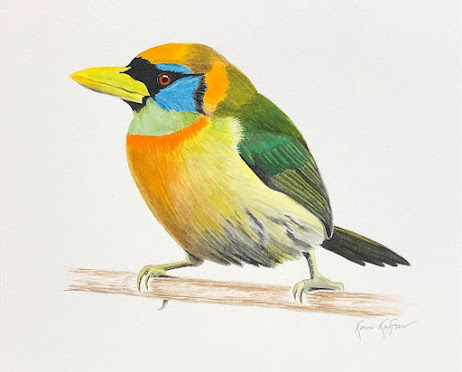Roseate Terns
| Adult Roseate Tern on Eastern Egg Rock, Maine, in June 2011. |
About ten days ago, thanks to the generosity of Dr. Steve Kress and his highly successful Project Puffin, Kimberly and I were able to visit Eastern Egg Rock, in the Gulf of Maine. We did see puffins there, and many other birds as well; maybe Kim will blog about the puffins (hint, hint). But I was most pleased by the opportunity to look closely at Roseate Terns.
Some treatments of tern identification focus on bill color. The mostly-blackish bill of Roseate Tern can be useful for quick ID, but it’s tricky, too: other terns have blackish bills for part of the year, and in transitional stages they can show color patterns much like that of the Roseate’s bill. The SHAPE of the bill is a better confirming point. It’s relatively long, thick at the base and tapered to a fine tip, with the gonydeal angle on the lower mandible located fairly close to the base of the bill.
Wing pattern is one of the best ID points. Summer adults typically have dark outer vanes on only the outer three primaries. When the wing is folded, this shows up as a limited dark area on the wingtip.
Here’s a closeup of the wingtip from the previous photo. Looking at the top of the near wing (the one on this side of the bird!), we can see dark gray on the three longest feathers, while the rest of the primaries (stacked up toward the left) are paler silvery gray.
The wing pattern can be even more obvious when the wings are spread. In this photo, on the far wing, the dark gray is clearly limited to only the three longest primaries. On the nearer wing, we can see that there is no dark trailing edge to the wing at all.
Compare that underwing pattern to the one shown by this Common Tern, photographed at the same place and date. The black trailing edge to the outer primaries is obvious at a glance.
| Adult Common Tern in flight, Eastern Egg Rock, Maine, in June 2011. |
Roseate Tern is a widespread species, found from the North Atlantic to the Indian Ocean, but it is not abundant anywhere. Its North American populations have declined seriously, so it is now listed as Endangered in the northeastern USA and eastern Canada, and as Threatened in the southeastern USA. The nesting Roseates on Eastern Egg Rock (along with about equal numbers of Arctic Terns, and many more Common Terns) are closely monitored and protected by Project Puffin, a great program that deserves the support of birders everywhere.



Great post and crippling pictures Ken...not a species that seems to migrate into the blogosphere very often.
ReplyDeleteI think their flight is another keen id point they fly quite differently to Arctic and Common , the wings beat the air in quick shallow strokes almost like a hovering kestrel and their call can be heard fairly easily when in a party of common or arctic terns.
ReplyDeleteThanks, Steve -- and I agree about the flight style and call, Peregrine. At the colony, we were able to pick them out easily in flight by the overall whitish look and the shallow wingbeats. I talk about those points in the book, but in this blog post I was mainly focusing on a few things that were obvious in the pictures.
ReplyDeleteIncidentally, for those who haven't tried this: you can see a slightly larger version of each photo by clicking or double-clicking on it; and then you can go back to the blog by hitting the "back" arrow on your browser. Some of the details will show up better if you enlarge the pix.
ReplyDeleteWhat a great article! Thanks!!
ReplyDeleteOh man--I may not know too many birds (yet), but I have a huge life list of prominent birders. Does that count? No. But at least I have a lot of people who can tell me what I'm (usually not) seeing. Eastern Egg Rock, now...my disabled sister clambered on to that one with nothing but an oxygen tank, a Snickers bar and spunk, searching for her totem puffins. I have a friend who got so involved with puffin monitoring on the Rock that she made me make her a papier-mache puffin, and in a fit of fervor I made her two, at probably thirty hours each. Unfortunately that triggered her odd-number tic, and she politely requested one more. I think I'm done now.
ReplyDeleteAwww, Shucks, Murr! As soon as I read "papier-mache puffin" I was all, MUST. HAVE. PAPIER-MACHE. PUFFIN. But, I understand that 30 hours is pretty intense. I promise not to tell Steve Kress about this, either!
ReplyDeleteHello Kenn and Kimberly,
ReplyDeleteBeautiful and educational shots of a cool species. Thanks for this and all your other interesting posts. Kenn, thank you as well for your Field Guide to Advanced Birding - an outstanding book as expected. Do you anticipate a new edition of your Field Guide to Birds of NA at some point on the horizon?
Kevin
The explanation about the bird and how it flies was really interesting. I especially enjoyed the diagram of the back feathers and how they help in the flight. Thanks for the information.
ReplyDeleteExcellent photos of a beautiful bird! A nice set of id tips for a long time nemesis bird. Why is it birds that one has yet to see capture the imagination so completely?
ReplyDeleteWilliam
Yes, terns could very well be the ultimate summer birds and Roseates might be the most elegant representatives of this family. Thanks for sharing those beautiful images and ID tips.
ReplyDelete